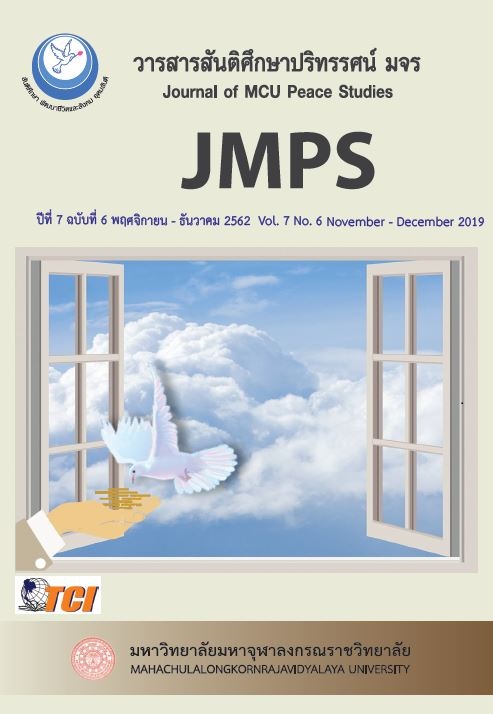Rebranding Thailand through the Phenomenon of the Dark Cave and the 13 Wild Boars
Main Article Content
บทคัดย่อ
This paper aims at initiating an opportunity of Thailand’s tourism to rebrand its communication theme by leveraging the phenomenon of the 12 football players and their coach being caught in a dark cave, and a miraculous heroic rescuing operation, which has captured the world’s attention. The paper is a documentary research by reviewing various concepts, principles, and theories pertaining to rebranding and tourism development. The findings point out an opportunity to add adventure tourism to the saturated imagery of cultural and traditional elements, which is the theme of Amazing Thailand for decades. The concept of rebranding should be initiated, and the task force consisting of all stakeholders should work together in an integrated fashion to develop and promote the site of the dark cave as a new tourism destination. Resource audit should be in place to develop tourism on RBV base, and it should be community-based tourism to get consents and co-operation from community residents. The development should take into account the principles of sustainable tourism, and the Balanced Scorecard concept should be employ to measure the efficiency and effectiveness of the project.
Article Details
ทัศนะและความคิดเห็นที่ปรากฏในบทความในวารสาร ถือเป็นความรับผิดชอบของผู้เขียนบทความนั้น และไม่ถือเป็นทัศนะและความรับผิดชอบของกองบรรณาธิการ ยินยอมว่าบทความเป็นลิขสิทธิ์ของวารสาร
References
Anholt, S. (2008). From nation branding competitive identity – The role of brand management as a component of national policy. In K. Dinnie (Ed). Nation branding: concepts, issues, practice. (pp. 22-23). UK: Butterworth-Heinemann.
Anholt, S. (2010). Definitions of place branding-working towards a resolution. Place Branding and Public Diplomacy, 6(1), 1-10.
Baker.B. (2007). 15 Common Destination Branding pitfalls and How to avoid them. Retrieved July 2, 2018, from http://www.destinationbranding.com/articles/15-pitfalls.pdf.
Barney, J., Wright, M., & Kitchen, D. J. (1991). The resource-based view of the firm: ten years after. Journal of Management, 27, 1991, 625-641.
Barney, J. (1996). The resource-based theory of the firm. Organization Science, 7(5), 470-476.
Barney, J. B. (1986). Strategic factor markets: expectations, luck and business strategy, Management Science, 32(10), 1231-1241.
Cosic, R., & Shankes, G. and Maynard, S. (2012). Towards a Business Analytical Capability Model. (23rd ed.). n.p.
Dinnie, K. (2008). Nation branding: Concepts, issues, practice. UK: Butterworth Heinemann Dutton.
Gray, B. (1989). Collaborating: Finding Common Ground for Multiparty Problems. San Francisco: Jossey-Bass.
Gilmore, F. (2002). A Nastional-Can it be Repositioned? Spain. The success Story of nation branding. Journal of Brand Management, 4(5), 281-291.
González MI. (2011). Websites and place branding for seven Galician Cities: Anexploratory study. Catalan Journal of Communication & Cultural Studies, 3(2), 297-304.
Gow, D. G., & Vansant, J. (1983). Beyond the rhetoric of rural development participation: How can it be done? World Development, 11, 427-446.
Hall, C. M. (1994). Tourism and politics: Policy, power and place. Chichester: Wiley.
Rohm, H. (2008). Using the Nalanced Scorecad to Align Your Organization. US: Balanced Scorecard Institute.
Jamal, T.B., & Getz, D. (1995) Collaboration theory and community tourism planning. Annals of Tourism Research, 22(1), 186–204.
Kaplan, R.S., & Norton, D.P. (1992), The balanced scorecard – measures that drive Performance. Harvard Business Review, 70(1), 172- 180.
Kaplan, R. S., & Norton, D. P. (1993). Putting the Balanced Scorecard to Work. Harvard Business Review, September- October, 134- 147.
Kavaratzis, M., & Ashworth, G.J. (2005). City branding: an effective assertion of identity or a transitory marketing trick? Tijdschrift voor economist en sociale geografie, 96(5), 506-514.
Keller, K.L. (2003). Strategic brand management: Building, measuring and managing brand equity. New Jersey: Upper Saddle River.
Plew, A. (1996). Adventure travel and ecotourism in Asia. Annals of Tourism Research, 23(3), 723-724.
Blackstock, K. (2005). James Hutton Institute A critical look at community based tourism Community Development Journal, 40(1), 39-49.
Lewis, R.C., & Chambers, R.E. (2000). Marketing leadership in the Hospitability industry: Foundations and practices. New York: John Wiley & Sons.
Muhana, E. (2006). Sustainable Tourism Development and Environmental Management for Developing Countries. Problems and Perspectives in Management, 4(2, 15-30.
Murphy, P. E. (1988). Community Driven Tourism Planning. Tourism Management, 9, 96-105.
Ndlovu, J., & Heath, E. (2010).Destination Branding in Zimbabwe: From Crisis to Recovery. Tourism Anal, 16(1), 87-97.
Olszak, C. M. (2014). Towards an Understanding Business Intelligence. A Dynamic Capability-Based Framework for Business Intelligence. Proceedings of the 2014 Federated Conference on Computer Science and Information Systems, pp. 1103–1110.
Weber, K. (2001). Outdoor Adventure Tourism: A Review of Research Approaches. Annals of Tourism Research, 28(2), 360-377.
Reed, M.G. (1997) Power relations and community-based tourism planning. Annals of Tourism Research 24 (3), 566–591.
Todaro, M. P. (1994). Economics for a development world. New York: Longman.
United Nations Environment Program. (2005). World Tourism Organization Making Tourism more Sustainable-A Guide for Policy Makers; UNWTO: Madrid, Spain, 2005 pp. 9 and United Nations. Towards a Sustainable Development Agenda.
Tourism Working Group. (2003). Sustainable Development of Tourism Destinations .Tourism Leisure & sports.
Vajirakachorn, T. (2011). Determinants of Success for Community-Based Tourism: The Case of Floating Markets in Thailand. Ph.D. Thesis, Texas A&M University, College Station, USA.
Wernerfelt, B. (1984). A resource based-view of the firm. Strategic Management Journal, 5(2), 171-180.
Zuckerman, M. (1990). The Psychophysiology of Sensation Seeking. Journal of Personality, 58(1), 313-345.

